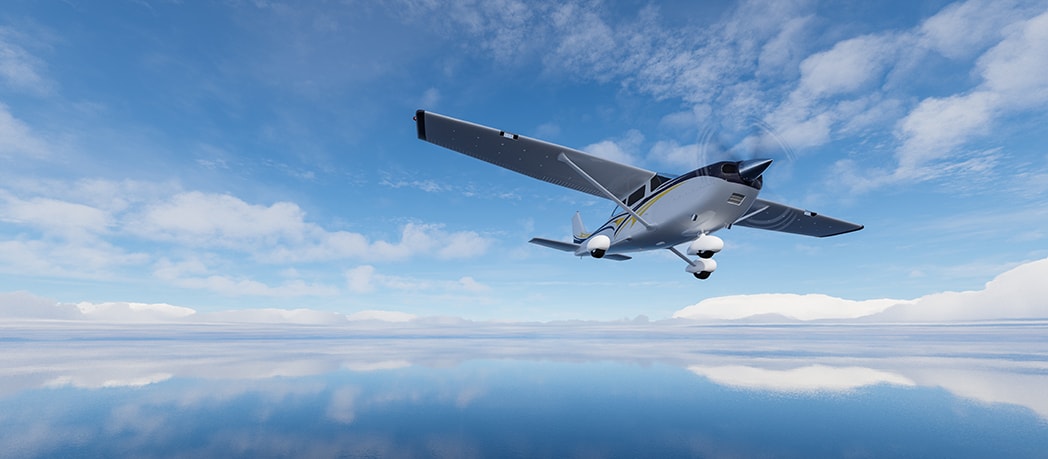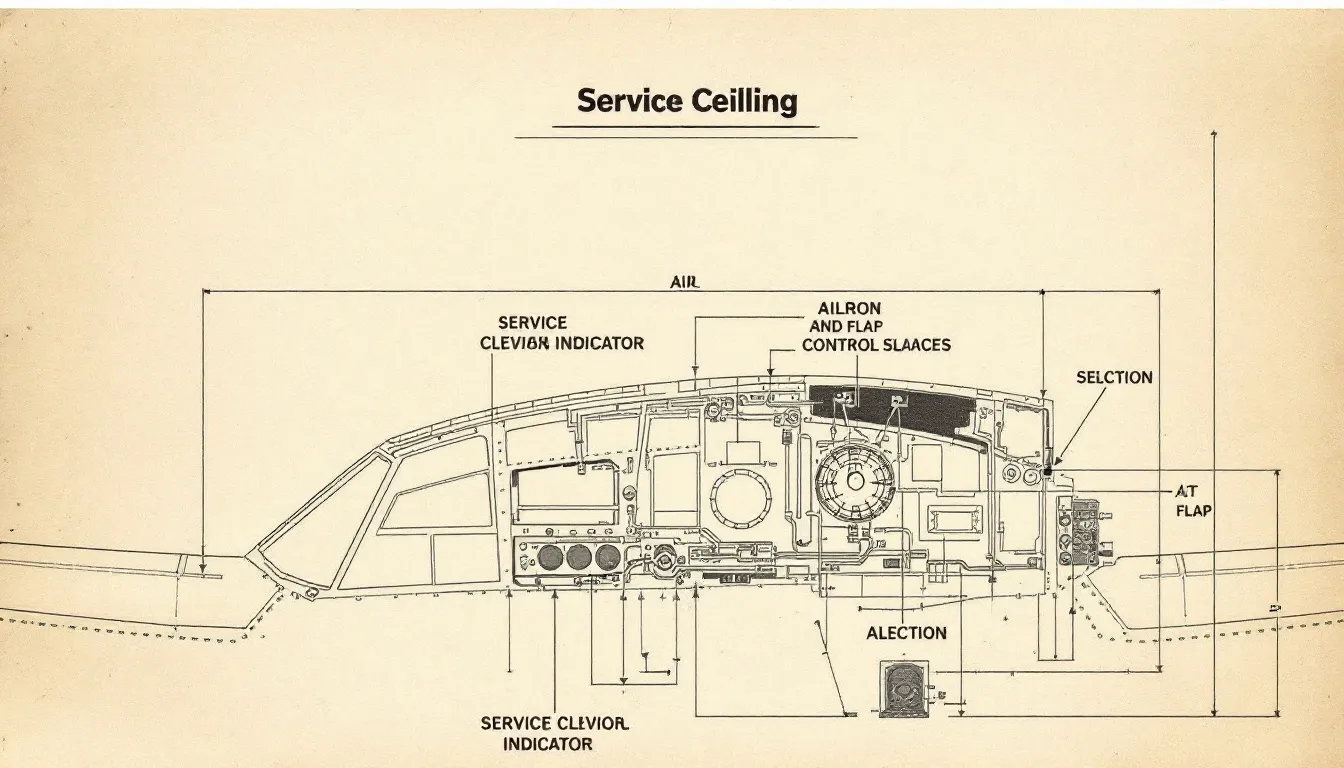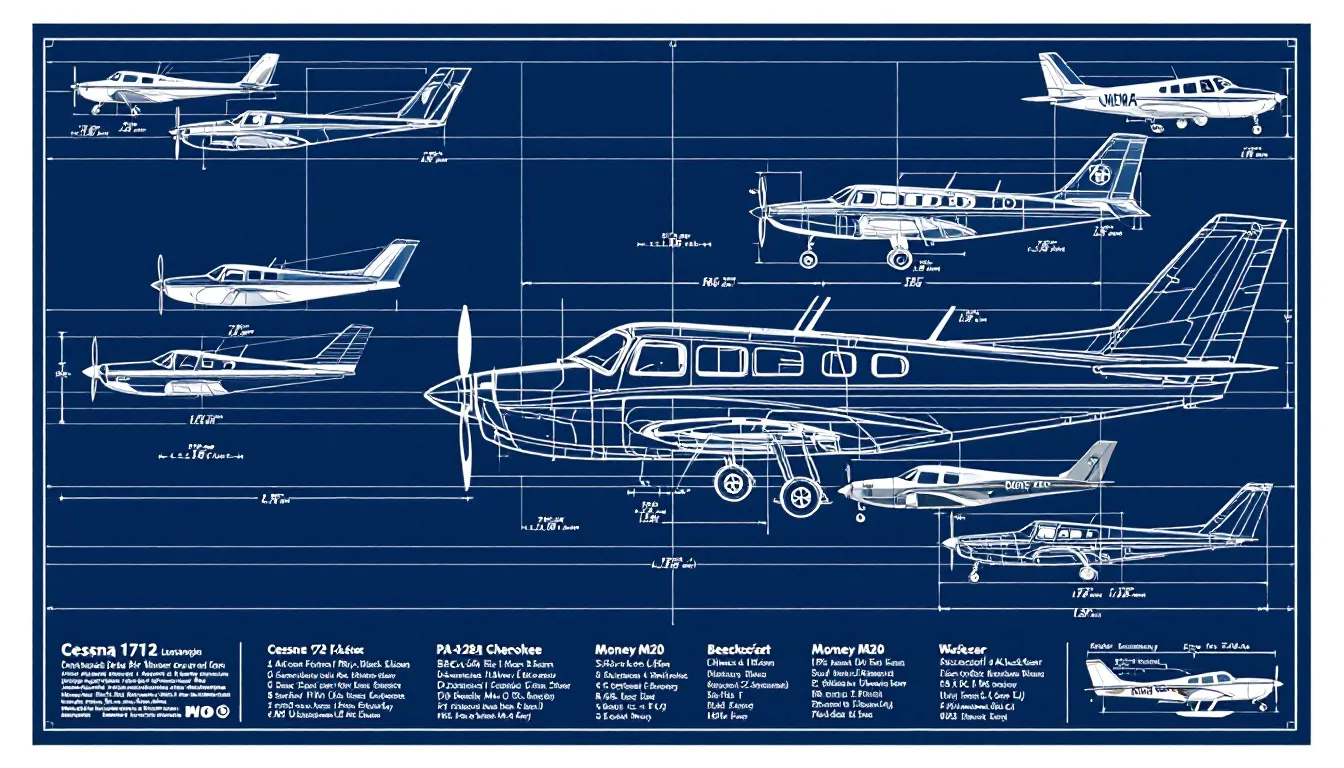Cessna 172 Max Altitude: How High Can It Fly?
Mar 31, 2025
The Cessna 172, a popular light aircraft, has a maximum altitude, or service ceiling, of approximately 14,000 feet, which is often referred to as the Cessna 172 max altitude.
Key Takeaways
-
The Cessna 172’s max altitude is between 13,000 to 15,000 feet above sea level, optimal cruising altitude is 3,000 to 5,000 feet for efficiency.
-
Factors that affect the aircraft’s max altitude are air density, atmospheric conditions, gross weight and engine power, all critical to performance.
-
Practical flying considerations like wind and weather is key to getting the most out of the Cessna 172 and flying safely.
Understanding the Cessna 172
The Cessna 172 is a single-engine, four-seat, high-wing aircraft that has been a staple in aviation since its first production model in 1956.
Renowned for its reliability, ease of handling, and fuel efficiency, the Cessna 172 has become one of the most popular training aircraft in the world. With a maximum altitude of 13,000 to 15,000 feet, it offers a balance of performance and accessibility that appeals to both novice and seasoned pilots.
The aircraft boasts a maximum cruise speed of 140 knots (259 km/h) and a service ceiling of 14,000 feet (4,267 meters), making it suitable for a variety of flying conditions.
If you're wondering how fast is a Cessna 172, its cruising speed is 140 knots, providing an ideal balance of speed and efficiency for cross-country flights.
Additionally, the Cessna 172 has a maximum range of approximately 700 nautical miles (1,296 km), allowing for extended flights without frequent refueling stops. These features make the Cessna 172 a versatile and dependable choice for pilots looking to explore the skies.
Understanding Maximum Altitude

The maximum altitude is the highest an aircraft can fly and remain level. That’s the magic number for Cessna 172 pilots.
While this is a theoretical figure, in reality the Cessna 172 cruises between 3,000 and 5,000 feet above sea level. That’s where it’s the most fuel efficient and performs best.
The cruising altitude is more than just numbers. It’s the sweet spot where an airplane can fly efficient and comfortable.
Flying at cruising altitudes of 4,500 to 5,500 feet also provides better visibility, enhancing navigation and safety from terrain.
Within these elevations, Cessna 172 pilots get maximum fuel efficiency which means more range and overall better performance – critical if you’re going on a long trip or want to spend more time in the air with minimal refueling stops.
Choosing the right cruising altitude involves considerations like fuel economy, passenger comfort and avoiding areas of turbulence while using favorable weather conditions for smooth flying throughout your trip.
Knowing an aircraft’s maximum altitude also helps with planning and command during flight.
Flight Nerd Airforce
At Flight Nerd Airforce, we offer resources to help you master aviation, from Cessna 172 flight techniques to pilot training. Join our community for expert tips, on-demand courses, and advice from experienced pilots with 20+ years in the industry. Start your journey to becoming a confident pilot today.
Service Ceiling of the Cessna 172

The service ceiling is the highest altitude an aircraft can reach while still able to maintain a minimal rate of climb. For the Cessna 172 it’s between 13,000 and 15,000 feet above sea level and depends on conditions and model.
For example, the first production model of the Cessna 172 had a service ceiling of around 13,500 feet, while later models like the Cessna 172 SP have a service ceiling of around 14,000 feet.
When flying at those heights, you can still climb upwards, but the rate of climb will decrease significantly as you approach that boundary.
That maximum sustainable height is determined by the engine efficiency and air density.
At around 15,000 feet that’s the absolute ceiling limit. Beyond that there’s no climb left for a Cessna 172. Pilots must not exceed those limits as both safety and performance will suffer greatly beyond those limits.
Flying at or near an aircraft’s service ceiling requires attention from pilots, when climbing towards roughly halfway into altitudes from 13,500 up to 14,000 there will be significant drops in how fast you can climb.
Knowing where you can fly especially when dealing with tricky terrain or unexpected weather situations is key when planning your flight.
Factors Influencing Maximum Altitude
The maximum altitude a Cessna 172 can go is determined by many factors, one of which is air density. As you climb altitude, air gets thinner, which reduces lift and engine power of the aircraft. It gets harder to maintain climb performance at higher altitudes.
Temperature and pressure of the atmosphere also plays a big role in dictating the highest altitude you can reach with a Cessna 172.
When temp rises, engine power goes down, making it harder to get higher. When temp gets cooler, engine efficiency goes up but also introduces ice formation hazard.
The weight of the aircraft also greatly affects its ability to climb. This is true for the Cessna 172 too. More weight means less climb capability, which means you can’t fly higher.
Pilots must consider not just passenger count but also luggage and fuel load when planning their flight, so they stay within safe parameters.
Finally, how much power an engine produces has direct impact on reaching certain altitudes with any aircraft – including this model plane we’re talking about here - since engines lose some power at higher levels (mainly because there’s less oxygen up there, which engines need).
Generally speaking, optimal performance on rate-of-climb vs consumption happens around 7,500 feet above sea level. Keep these in mind and you’ll be able to plan your route and ensure safety & economy while flying!
Climbing and Descending
Climbing and descending are the most critical parts of flying and require attention to detail. In a Cessna 172 you can climb at 1,200 feet per minute (6.1 meters per second) and get to cruising altitude quickly.
But you must pay attention to the transition layer especially above 10,000 feet as that’s where cruising is not recommended.
When descending, planning is key to a safe and controlled landing. The Cessna 172 stall speed is 45 knots (83 km/h) which is something to consider when descending to avoid loss of control.
By understanding these parameters and planning accordingly, you can make smooth and safe transitions between phases of flight.
Performance at High Altitudes

Performance of the Cessna 172 at high altitudes is affected by temperature and air pressure. As the plane climbs the air is less dense and engine power output is reduced, rate of climb is lower and it’s harder to get and maintain high altitude flight.
For long haul flights on a Cessna 172 you will notice more fuel consumption at higher altitudes as more power is required to maintain performance.
Managing fuel is crucial to ensure you have enough reserves to complete your journey without having to make an emergency stop for refueling.
At high altitude, where the air is less dense, overall climb rate to maximum cruising speed is affected. The less air density makes the engine work harder to maintain its performance. So, pilots must adjust their flying to prioritize safety and efficiency.
Safety Considerations
Safety first when flying a Cessna 172. With a great safety record the Cessna 172 has a lower accident rate than many other planes in its class. But that doesn’t mean you can be complacent. Vigilance and following procedures are key to keeping that record.
Regular maintenance and inspections are critical to the aircraft’s safety and reliability. You must always be aware of your surroundings and prepared for the unexpected. By prioritizing safety and following best practices you can enjoy flying a Cessna 172 and minimize the risks.
Comparison with Other Aircraft

When looking at the Cessna 172’s max altitude versus other aircraft, you can see some big differences. The smaller and older Cessna 150 can go up to 15,300 feet with optimal conditions, due to its lighter weight and engine. It’s good for many kinds of flying.
Meanwhile, modern Boeing 737s cruise at 41,000 feet. That’s a big range of capabilities across different types of aircraft.
Here’s a quick comparison of service ceilings for some other popular light aircraft:
-
Piper PA-28 Cherokee: 13,000 feet
-
Cessna 182 Skylane: 17,000 feet
-
Cirrus SR22: 20,000 feet
The Cessna 172 is good for recreational flying, primary training, and short to medium trips – and understanding these different altitudes helps you pick the right plane for your needs.
If you’re into aviation or have professional interests therein: these comparisons highlight the importance of choosing a plane for your specific purposes.
While the Cessna 172 is all about adaptability and ease of use, other models might have better performance at higher elevations or longer range – things to consider when planning your flight.
Knowing the different max elevation parameters gives you a broader understanding of what you can expect from flying the Cessna 172. Knowing your own fleet limitations and proficiency guarantees will get you both fun flying and compliance.
Practical Flying Considerations
To get the most fuel efficiency and capability out of a Cessna 172 you need to pay attention to practical flying. Wind patterns are a big deal.
Tailwinds can add to climb rate; headwinds can reduce performance. Pilots need to factor those in to ensure both efficiency and safety.
When en route, pilots must consider the altitude at which they are flying to optimize fuel efficiency and overall flight dynamics.
Weather and airspace are big too. Pilots have to prepare for weather challenges like turbulence and navigate clear of controlled airspace to avoid conflicts.
Flying above 10,000 feet often gets you out of tower controlled airspace and you can fly in a straight line.
Fuel efficient operations are key when flying a Cessna 172. You need to make sure your plane can get to its intended altitude without using too much fuel or taking too long to climb.
By doing thorough flight planning and staying aware of your surroundings you can achieve efficiency and high safety standards by following a detailed flight plan that also saves fuel whenever possible.
Training and Experience
The Cessna 172 is a favorite among flight schools and instructors, making it an ideal aircraft for primary training. Its ease of handling and forgiving nature allow students to develop their skills and build confidence in a supportive environment.
One key feature that aids in this process is the Cessna 172 cockpit, which is designed to be intuitive and accessible for pilots at any experience level.
For experienced pilots, the Cessna 172’s reliability and fuel efficiency make it an excellent choice for long haul flights and recreational flying.
Whether you are a seasoned aviation enthusiast or just starting your journey in the skies, the Cessna 172 offers a dependable and enjoyable flying experience. Its versatility and user-friendly design make it a valuable asset for pilots of all levels, ensuring that every flight is both safe and rewarding.
Real-World Examples

Pilots have flown the Cessna 172 to over 14,000 feet and have documented the experience. These real world examples give you a clear understanding of the aircraft’s high end capabilities and limits so you can reference.
During an instructor training session a flight instructor took a student to 13,500 feet. Practical examples like this are important to understand how the aircraft performs outside of the simulator or theoretical world.
Near the top of the climb pilots often experience reduced power and slower rates of climb with their Cessnas. That’s why it’s so important to be cautious and watch the fuel and engine when flying at high altitudes.
The info from these experiences shows that planning and situational awareness are key during these types of flights.
Summary
Knowing the Cessna 172’s high end is key to flying safe and smart. The service ceiling, affected by air density, temperature and weight, is a realistic limit of the aircraft’s capabilities.
By looking at the Cessna 172 compared to other aircraft in tangible terms pilots get valuable insight into what this plane can do.
Having this knowledge lets you fine tune your flying while keeping safety and fun in mind.
Whether you’re an old hand or new to flying, mastery of these principles will make you more capable and comfortable in a Cessna 172. Go high within safe limits and enjoy the ride.
Frequently Asked Questions
What is the maximum altitude a Cessna 172 can reach?
The Cessna 172 can reach a maximum altitude of approximately 14,000 to 15,000 feet, varying by model and atmospheric conditions.
How does air temperature affect the Cessna 172's performance at high altitudes?
Air temperature significantly impacts the performance of the Cessna 172 at high altitudes, as higher temperatures reduce engine power output, thereby hindering the aircraft’s ability to climb and maintain altitude.
Hence, pilots must consider these effects when operating under warmer conditions.
What factors should pilots consider when selecting an altitude for flight?
When selecting an altitude for flight, pilots should take into account wind patterns, weather conditions, airspace restrictions, and fuel efficiency.
These factors are crucial for ensuring a safe and efficient flight.
How does the Cessna 172 compare to other aircraft in terms of maximum altitude?
The Cessna 172, with a maximum altitude of approximately 14,000 feet, is indeed lower compared to various other aircraft, including the Cessna 150 and modern jets like the 737.
Thus, it is essential to consider your flying needs when comparing aircraft capabilities.
Why is understanding the service ceiling important for pilots?
Pilots must grasp the importance of an aircraft’s service ceiling, as it guarantees that they can safely operate the craft while maintaining efficient performance and a stable ascent when reaching elevated altitudes.
